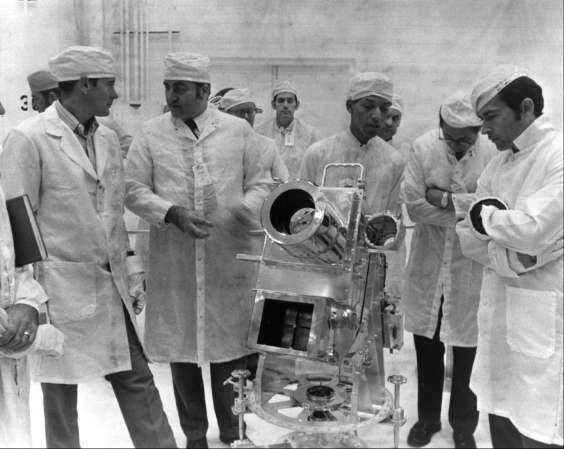
Chapter 23
Scientific investigations highlighted the last three Apollo missions. The cold war competition that had put men on the moon was fading. Congress and the American public now wanted tangible benefits from space expenditures. NASA adjusted its manned programs to the new climate. Skylab, the post-Apollo manned program, would focus on practical applications, most of them earth-oriented. Apollo, reduced by funding cuts to three more missions, would emphasize lunar exploration. Missions 15-17 did not disappoint American scientists; indeed those missions proved a fitting climax to one of the nation's great achievements.

Discussing the lunar surface ultraviolet camera during an experiments review in the operations and checkout building, November 1971. From left, lunar module pilot Charles Duke; Rocco Petrone, Apollo Program Director; George Carruthers, Naval Research Laboratory, the principal investigator for the camera; and Apollo 16 commander John Young.
NASA's plans for the concluding Apollo missions were announced on 2 September 1970. Modifications to the spacecraft and astronaut support systems would double the time the astronauts could stay on the moon. The weight devoted to lunar surface experiments would also double. A lunar rover vehicle - an appropriate gift to the moon from an America-on-wheels-would more than double the distance the astronauts could travel on the surface. Other new equipment included a lunar communications relay unit, which enabled the crew to maintain contact with earth while exploring beyond the lunar module's horizon. Transmissions from the portable relay station to Houston included voice, TV, and telemetry. Although the suitcase-sized device was normally mounted on the front of the rover, it could be detached and carried by an astronaut - a feature that ensured the crewmen a means of communication if they had to walk back to their spacecraft. The rover also mounted television cameras that were operated by remote control from Houston.1
The command-service module's lunar orbiting experiments, while less dramatic, were a vital part of the last missions. The scientific instrument module (SIM) in Apollo 15's service module included three spectrometers - gamma-ray, x-ray fluorescence, and alpha-particle - to measure the composition and distribution of the lunar surface. A mass spectrometer would measure the composition and distribution of the lunar atmosphere. A subsatellite, ejected from the SIM bay into lunar orbit, would beam earthward information about solar winds, lunar gravity, and the earth's magnetosphere and its interaction with the moon. Other equipment in the SIM, two cameras and a laser altimeter, would map about 8% of the lunar surface, in all some three million square kilometers.2
The extended missions on the moon required major modifications to the lunar module. Supplies of water, oxygen for the portable life support system, and electrical power were increased. Grumman enlarged the capacity of the propellant tanks by 7% and redesigned the descent stage to make room for the lunar rover. Altogether, the lunar module modifications and the SIM additions added about 2,270 kilograms to the Apollo 15 spacecraft, bringing its total weight to over 48 metric tons.3 This put a burden on Saturn engineers. Marshall and its contractors met the payload increase through minor hardware changes in the S-IC stage and by revising the Saturn V's flight plan. The hardware modifications reduced the number of retrorocket motors, rebored the orifices on the F-1 engines, and set the burning time for the outboard engines nearer LOX depletion. Better use of the Saturn's thrust was achieved by launching the AS-510 rocket in a more southerly direction (changing the launch azimuth limits from 72-96 degrees to 80-100 degrees) and by using an earth parking-orbit of 166 rather than 185 kilometers. Apollo 15 also stood to gain some advantage from the July launch date, when temperature and wind effects would be favorable.4
| Next |